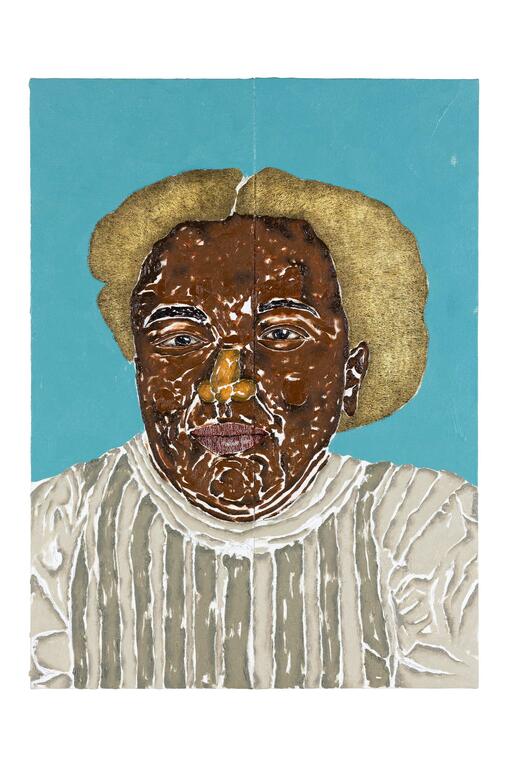
Dalton Paula: retratos brasileiros [Brazilian Portraits] Dalton Paula
MASP – Museu de Arte de São Paulo Assis Chateaubriand and the Ministry of Tourism present, from July 29th to October 30th, 2022, the solo exhibition Dalton Paula: retratos brasileiros [Brazilian Portraits], which occupies the mezzanine on the first underground floor of the museum. Curated by Adriano Pedrosa, artistic director at MASP, Glaucea Britto, assistant curator at MASP, and Lilia Schwarcz, guest curator of histories, the exhibition brings together 45 paintings that portray Black leaders and personalities historically invisibilized in Brazil. Twelve of these works were produced from 2019 to 2022 with financial support from the museum and then donated to MASP by the artist. The show counts on master sponsorship by Bradesco, sponsorship by Livelo, and support by Lefosse.
Dalton Paula (1982 – Brasília) lives and works in Goiânia, Brazil, where he graduated in Visual Arts at the Universidade Federal de Goiás (UFG). His artistic practice makes use of several languages, such as painting, performance, installation, photography, and object, to highlight relationships between image and power. In his repertoire, the central figure is the Black body in diaspora, its rites and rituals, with emphasis on portraits of Black personalities that constitute a proposal to review the official historiography of Brazil.
The exhibition Dalton Paula: Brazilian Portraits brings works from different phases of the artist's trajectory, from 2018 to the present day, and thirty of them are being exhibited for the first time. The works are the result of a long artistic process that begins with the selection of biographies, goes on to research and collect documents, such as photos and clippings, and then proceeds to the production phase. "It is possible to say that the paintings talk to each other, as if they are close friends, expressing their personalities, philosophies, and practices. They are made collectively, just as the ancestral teachings that are equally collective," reflects curator Lilia Schwarcz.
In his research, Paula revisits issues from official historiography and art histories as subject matter for the creation of his portraits, in order to give new meanings and place the contributions of Afro-Brazilian personalities as protagonists. An example of this is the use of photography, in which the artist subverts the supposed photographic objectivity and its value as a historical record by using contemporary photographs of people from the quilombo Alto Santana, in Goiás, and of Black personalities from different origins and historical periods as a basis for the creation of some of his new portraits through painting.
In the construction of the works, the artist explores the resource of color to evoke different meanings and also as a metaphor for the occupation of other spaces: of art, history, and society. "Color has been thought of as a strategy both to not allow the framing of his production in certain aesthetic categories that subordinate it and to 'call the eye to dance' through the layers of paint and meaning that give shape and prominence to his characters," reflects curator Glaucea Britto.
The use of two canvases to compose each portrait is another striking visual feature of Paula's work, acting as a metaphor for the research process experienced by the artist in the quilombola communities, where it is possible to search for traces and join fragments in the reconstruction of a history that remains open, cracked, indicating other possibilities of meaning. As Lilia Schwarcz describes: "the artist seeks a vocation in the present without getting rid of the violence of the past. So much so that he 'breaks' his portraits in two, two united canvases that allow a glimpse of the crack. This way, both the incompleteness and the fullness of these people become apparent.
In his most recent works, the artist adopts areas without paint, suggesting a history in reconstruction. The 22-carat gold leaves used as adornments in the hair of portrayed figures praise the central importance of the head in Afro-Brazilian traditions as a sacred place and honor the history of these personalities – some of them kings and queens on the African continent – who were enslaved in Brazil.
"The glow of the sun, the candle, and the flower of the senzala shine in the golden hair strands of his characters. Thus, for the artist, the process of building the color and applying the gold leaf is a kind of ritual that requires a high degree of concentration and technical refinement, often recorded in his study notebook," says Britto. "By articulating these various interpretative layers to the process of image construction, the portraits created by Dalton Paula confer dignity to Black men and women who have been objectified, stereotyped, and dominated by a visual tradition, whether of photography or painting, oriented by the white standard," she concludes.
Dalton Paula: Brazilian Portraits is part of the MASP's biennial program dedicated to Brazilian Histories (2021-22), on the occasion of the bicentennial of the independence of Brazil, in 2022. This year, the program also includes exhibitions by Joseca Yanomami, Madalena dos Santos Reinbolt (1919-1977), Judith Lauand, and Cinthia Marcelle, in addition to the major collective exhibition Brazilian Histories.